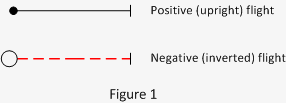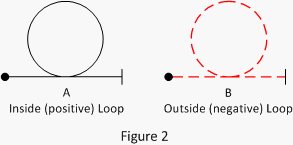All basic figures within Families 1 – 8 are drawn with some combination of solid and dashed lines. The solid lines indicate flight with a positive or zero angle of attack (AoA). That is, the wing is either generating no lift force (zero AoA) or the wing is generating a lift force away from the wheels (positive AoA). Flight with a negative AoA (i.e., the wing is generating a lift force acting toward the wheels) is depicted using dashed lines. Whether a line is drawn as solid or dashed is referred to as the “character” of that line. Positive and negative AoA are not to be equated with the upright and inverted airplane attitudes. To be sure, upright level flight is represented by a solid line and inverted level flight by a dashed line (Figure 1), but look at a regular loop (Figure 2A). If you analyze the attitude of the airplane as it flies around this loop, you will realize it is upside down (inverted) at the top of the loop. Yet the entire loop is drawn with a solid line. That’s because even though the airplane is physically inverted at the top of the loop, the airplane continues to have a positive angle of attack throughout the maneuver.


The outside (negative) loop (Figure 2B) is drawn entirely with a dashed line because even though the airplane is physically upright at the top of this loop, the airplane is flying with a negative angle of attack throughout the maneuver. These figures illustrate an essential point to remember about the character of the line, solid or dashed, and that is: line style may indicated attitude (in level flight), but it always indicates the angle of attack (positive or negative) of the airplane once established on the given line. Figures 1 and 2 also introduce two more symbols in the Aresti vocabulary: the small circle and the short cross line seen on either side of these figures. Every figure starts and ends in horizontal flight. The figure start is represented by a small circle, either filled in or open, as depicted in Figure 1, and the end of every figure is represented by a short cross line. Throughout this tutorial the negative lines are drawn in red. Using red to depict negative AoA is standard when printing in color, but it would mean exactly the same thing if drawn in black, or green, or any other color. It’s the fact that the line is dashed that’s important, not the color.
The previous discussion of line character also introduces some of the terms we use to describe aerobatic figures. In Figures 1 and 2, I have used the words “positive,” “upright,” and “inside” all to describe figures where the airplane is experiencing a positive angle of attack; and the words “negative,” “inverted,” and “outside” all to describe figures where the airplane has a negative AoA. Although these multiple terms mean the same thing, one term is generally more accepted than the others to describe a figure or maneuver in question. For example, Figure 2B would be better described as an ‘outside loop’ rather than a ‘negative loop.’ To generalize, looping lines are normally described as either inside or outside; snap rolls as either positive or negative; and spins as either upright or inverted.
The line style (solid or dashed), the start circle, and end cross line symbol are common across all Families 1 through 8. The easiest way to learn the remaining nine words in this Part 1 article on the Aresti language is to look inside the Catalogue at each of the Aresti Families in turn.

